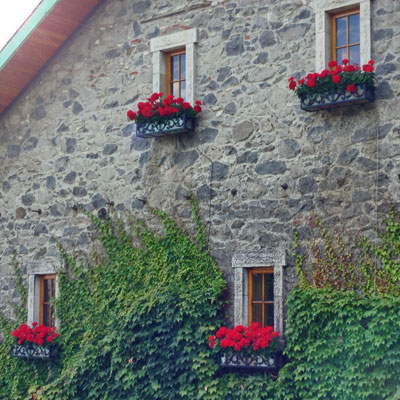 European Window Boxes European Window Boxes
When you walk through any town in Europe, its outstanding feature is its window boxes. Given that many European homes have little space for gardens, they make maximum use of window boxes. Their window boxes are abounding with color, texture, and vibrancy.
In addition to their aesthetic appeal, window boxes can provide a practical solution for growing herbs, vegetables, and flowers in small spaces. The use of window boxes dates back centuries, with each region developing its unique style and tradition. From the ornate and elaborate window boxes of Germany to the rustic and natural boxes of Italy, European window boxes are available in various styles, shapes, and materials.
The following article highlights the history behind European window boxes in the Alpine regions of Austria, Germany, and Switzerland. It also looks at how these window boxes differ from those in France and Italy. The article also provides aspiring gardeners with tips on creating similar window boxes.
A Brief History of European Window Boxes
The window boxes from each part of Europe hold a rich history and culture behind them. As you travel from the Northern to the Eastern parts of Europe you see the differences in style, color, and texture of the floral arrangement and the window boxes themselves. No two flower boxes in any part of Europe are the same.
Here is a brief history of window boxes from the Alpine regions, Germany, Austria, and Switzerland, and how these window boxes differ from those in France and Italy.
You can trace back window boxes in Germany to the Middle Ages. During this period, many people used them primarily for practical purposes, such as growing herbs and vegetables. This was because of space and food constraints.
However, with time, they began to use window boxes for decorative purposes. The tradition continued through the Baroque and Rococo periods, where they became increasingly ornate and elaborate. Today, window boxes are an essential part of the German architectural landscape, with many historic homes and buildings featuring beautifully crafted and ornate window boxes.
The use of window boxes in Austria is primarily for decorative purposes, focusing on bright colors and abundant foliage. In Austria, the tradition of using window boxes dates back centuries, with many homes and buildings featuring wrought iron or copper boxes filled with colorful flowers and greenery. Gardening enthusiasts design Austrian window boxes to complement the surrounding architecture and arrange them symmetrically.
The Swiss use window boxes to add charm and character to homes and buildings, often arranging them in a symmetrical pattern. Swiss window boxes are typically made of wood and are painted in bright colors or stained to complement the surrounding architecture.
Considering the medieval period, Austria, Switzerland, and Germany are well-known for their wooden crafts. Therefore several of their window boxes are created from wood. Later, with the introduction of metal, their window boxes took on the ornate, creative designs we find in several European window boxes. Wrought iron window boxes would hold pots or liners which then would display the flowers.
Brightly colored geraniums, petunias, and begonias are common flowers in European window boxes. These geranium varieties are bountiful and cascade over windows, railings, and planter boxes. You find many window boxes in these regions prefer to use the Alpine geranium, which is different from the usual ones that grow upright.
Window box creators use ivy to fill the spaces and to bring a bit of green to an otherwise colorful window box.
How Do Window Boxes In The Alpine Regions Differ From Those In France And Italy
Whether traveling within Switzerland, France, or Italy, you will notice a distinct difference not only in the languages between each town but also the differences in the architecture, building layout, clothing, and window box arrangements.
The window boxes between the regions differ in style, color preferences, window box material, and flowers. However, the common feature amongst the window boxes in these regions is that they were handmade by master craftsmen.
The Alpine regions use window boxes primarily for decorative and creative purposes. They focus on bright colors and abundant foliage and arrange the window boxes symmetrically. The plants used in Alpine window boxes typically tolerate cooler temperatures and shorter growing seasons.
French window boxes are typically made from wrought iron or terracotta and feature carefully arranged plants in various colors and textures. The plants used in French window boxes are often trimmed and pruned to create a tidy and well-maintained appearance. The French create a formal more structured type of window box.
The Italians create a more rustic and informal look with their window boxes. They typically make their window boxes from terracotta or other natural materials, and the Italians fill them with various plants, including herbs, flowers, and vegetables. Considering that the Italians greatly emphasize food, it is not surprising they prefer herbs and vegetables over flowers in their window boxes!
The plants the Italians use in their window boxes are often left to grow naturally, creating a more organic and rustic appearance.
Window Boxes In Ireland And Northern Ireland
You may not think it, but the Irish also have a history and love for window boxes. Considering Ireland's vast green open spaces, it does not surprise that the Irish would want to decorate their homes, shops, etc., with stunning window boxes.
As the popularity of gardening and horticulture grew the use of window boxes as a decorative feature became widespread during the 18th and 19th Centuries. The window boxes during this time were handmade from wood or metal.
The Irish used window boxes primarily to grow herbs, medicinal plants, and other plants for cooking and healing.
Early 20th Century, the popularity of window boxes in Ireland declined. With more people moving into the city, there was little need for window boxes.
Recently, however, many people are rediscovering the wonder and appeal of window boxes, and there is a resurgence in their popularity of them in Ireland.
The Irish use herbs in their window boxes, and some may use summer flowers like petunias, pansies, or cornflowers, although uncommon but a great addition to window boxes. Irish window boxes also use popular Irish flowers like fuchsia and primrose.
How To Create A European Window Box
Window boxes in Germany are typically filled with colorful blooms and cascading foliage, creating a lush and vibrant display. Italian window boxes are often made of terracotta or wrought iron and planted with fragrant herbs, such as rosemary and thyme. In England, their window boxes are traditionally filled with brightly colored annuals, such as petunias and geraniums, which provide a burst of color throughout the summer months.
Overall, window boxes have become an integral part of European architecture and culture, adding charm, character, and beauty to cities and towns throughout the continent. Whether simple or ornate, flower boxes remind us of nature's importance in our lives and the joy and beauty it brings to our surroundings.
Here are some ways to create your European window box in whichever part of your world.
Creating Alpine-style window boxes is relatively easy, and gardeners in North America can do this with a bit of creativity, planning, and effort. The first step is to select a window box with the appropriate right size and shape for your window. Wooden or metal window boxes and outdoor planters work well for an Alpine-style window box.
Next, fill the window box or planter with a high-quality potting mix and add plants that will thrive in your local climate. Select plants native to Alpine regions, such as pansies, petunias, lobelia, and geraniums, or alpine plants like rockcress, alpine toadflax, and mountain avens. Blend with some foliage plants, such as ivy or ferns, to add texture and interest to your window box.
The Alpine regions typically use monochrome colors, preferring geraniums in reds or pinks. Alternatively, they also combine the colors to create stunning window boxes. Most Alpine window boxes contain little foliage. The Swiss, especially, allow the flowers to speak for themselves.
Arrange the plants with taller plants in the back and shorter plants in the front. Use a mix of colors and textures to create a dynamic and exciting display. You can use a mix of fillers, spillers, and thrillers to complete your European window box.
Be sure to water your window box regularly and fertilize it with a balanced fertilizer to promote healthy growth.
Conclusion
European window boxes are a testament to the beauty and ingenuity of horticultural design. With their long and fascinating history, these boxes are an essential part of European culture and architecture, adding charm and color to buildings and homes throughout the continent.
From the elaborate and ornate boxes of Germany to the rustic and natural boxes of Italy, each region has developed its unique style and tradition regarding window boxes. Whether used for practical or decorative purposes, these boxes continue to be an essential aspect of horticultural design, with gardeners and plant enthusiasts finding inspiration and beauty in their colorful displays.
With the resurgence of interest in gardening and horticulture, window boxes are again becoming popular throughout Europe and beyond. Whether you reside in a small apartment or a large estate, window boxes can provide a practical and beautiful solution for bringing nature indoors and adding a touch of color and charm to your surroundings.
 About the Author About the Author
Matthew Buquoi is the owner of Flower Window Boxes, Inc., which is one of the largest online window box companies in the United States. In addition to being the owner, he is also an expert author, and regularly writes about industry topics in the window boxes, planters, exterior shutters, and home and garden industry.
|
|
|